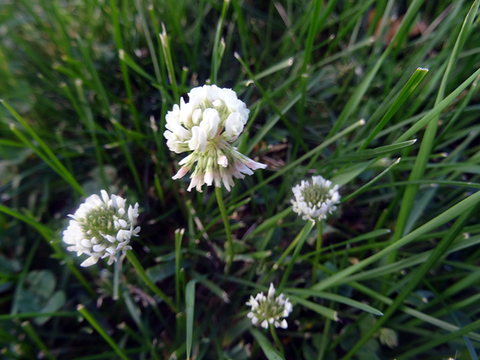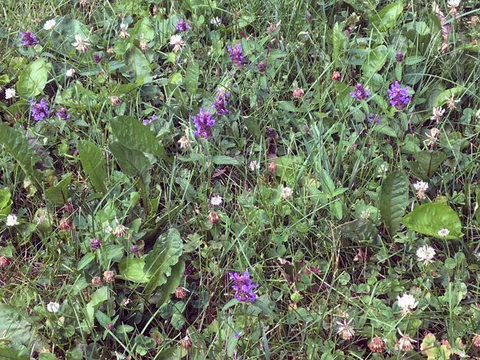Quick facts
- White clover (Dutch white clover) is an introduced plant that can be a weed in lawns but is also grown in many bee lawns to attract pollinators.
- White clover can be most easily identified by its white and light pink globe-shaped flower, leaves with a white crescent on the leaf surface, and smooth stems.
- Lawns with white clover may have low nitrogen levels and can be controlled by managing nutrients through fertilization.
- Chemical control should be done in the fall using a selective broadleaf herbicide.
Characteristics
White clover (Trifolium repens), also known as Dutch white clover, is a member of the Fabaceae family (legumes) that grows low to the ground. It forms perennial mats that spread 1 to 2 feet and grow from 3 to 12 inches tall.
White clover has poor traffic tolerance and does not grow well in shade.
Flowers
- White or slightly pink, globe-shaped clusters at the end of a singular green stalk consisting of multiple small flowers.
- Bloom time: spring to early fall.
Leaves
- Trifoliate, rounded, compound green leaves (3 leaflets) commonly have a white crescent on the surface of each leaf.
- Slightly serrated leaf edges with a shiny underside.
- Alternating growth.
Stem and roots
- Smooth (hairless), rounded stems creep along the ground, rooting at nodes.
- Consists of both fibrous and taproots.
- Taproot at the main plant, fibrous at nodes (joints) created by stolons (runners).
Where it thrives
White clover thrives in cool, moist soils with partial sun and is commonly found in lawns and landscapes.
This plant can indicate low nitrogen, compaction, and drought stress in soils.
Control and management
White clover is not always seen as a weed and is used in bee lawns, pastures, and living mulches. However, control may be necessary when grown in undesirable locations.
Turf
- Maintaining adequate soil nutrient levels helps reduce white clover growth, which can indicate low nitrogen content in soils.
- A dense and healthy turf is the best defense against white clover encroachment.
- Ideal herbicide application is in the fall; springtime applications are often ineffective.
- Most effective herbicides contain one or more of the following:
- Clopyralid
- Dicamba
- Fluroxypyr
- Florasulam
- Metsulfuron
- MCPP
- Quinclorac
- Triclopyr
- 2,4-D is ineffective.
Garden
- Dig out or hand-pull to remove small patches.
- Maintaining adequate soil nutrient levels helps reduce white clover growth, which can indicate low nitrogen content in soils.
Benefits to the landscape
White clover provides nitrogen to the soil through nitrogen fixation, breaks up compacted soils, acts as a ground cover, and attracts pollinators.
Many bee lawns promote the usage of white clover for its nitrogen fixation, bloom length, and forage quality for bees. White clover is also used as a beneficial pasture plant.
White Dutch clover and other legumes are commonly used as cover crops, green manures and living mulches.
- Green manures consist of tilling plants into soil to provide nutrients and organic materials.
- Living mulches are planted within other crops to assist in weed suppression, soil stabilization, nutrient management, and temperature control.
Conservation, invasive status, and native status
- White clover was introduced to the U.S.
- White clover is native to Europe, Asia, and Africa, and its arrival in the United States can be traced back to European colonization.
Plants that look similar
- Black medic
- Birdsfoot trefoil
- Yellow woodsorrel
CAUTION: Mention of a pesticide or use of a pesticide label is for educational purposes only. Always follow the pesticide label directions attached to the pesticide container you are using. Be sure that the area you wish to treat is listed on the label of the pesticide you intend to use. Remember, the label is the law.
St. John, L., & Ogle, D. (2009, January). White Clover Plant Guide - USDA Plants Database. Natural Resources Conservation Service. https://plants.usda.gov/DocumentLibrary/plantguide/pdf/pg_trre3.pdf
Reviewed in 2024




